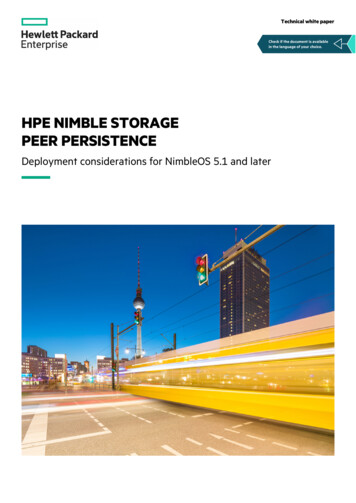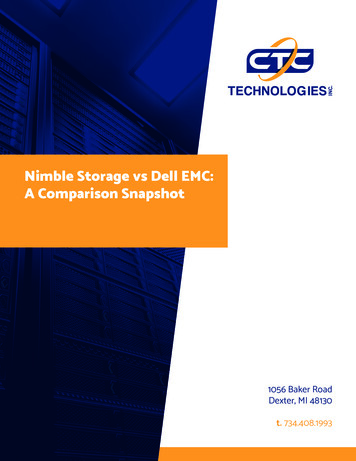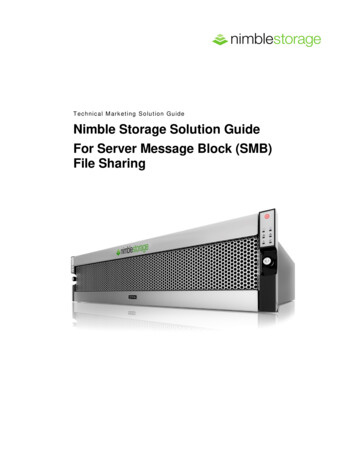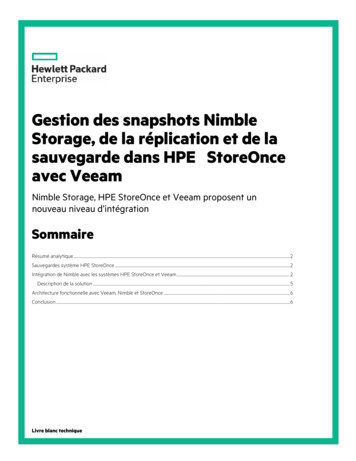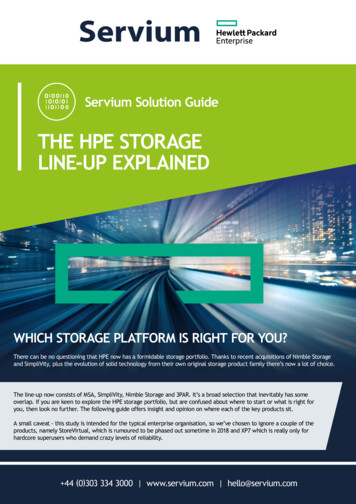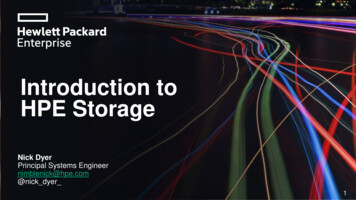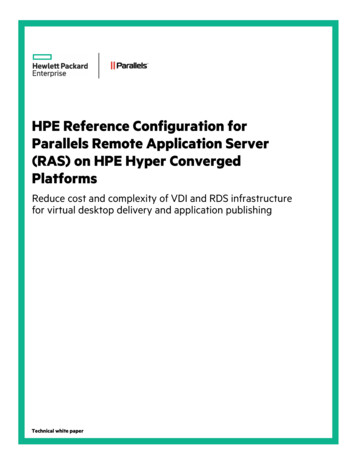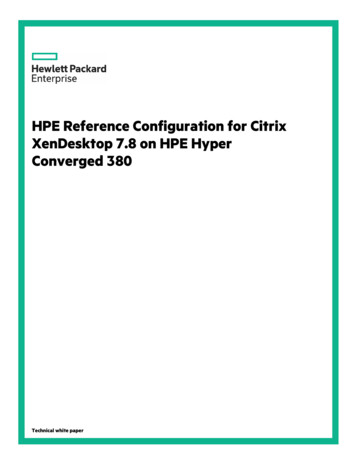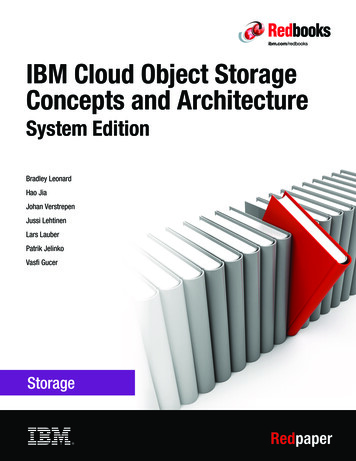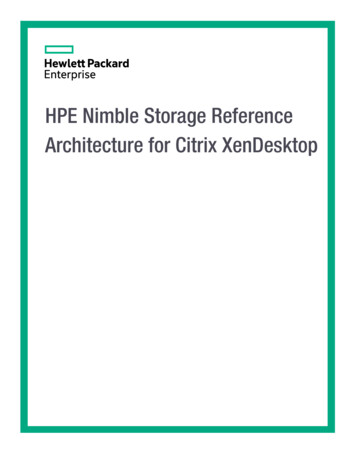
Transcription
HPE Nimble Storage ReferenceArchitecture for Citrix XenDesktop
ContentsOverview.5Audience.5Solution Summary.5HPE Nimble Storage Technical Overview.6All-Flash Array Hardware.6Universal Hardware Architecture.7Predictive Flash Platform.7HPE NimbleOS Architecture.8Unified Flash Fabric.8Transparent Application Migration.9HPE InfoSight.10VMVision for Hypervisor and VMware Monitoring.11Solution Design.12HPE Nimble Storage Design Fundamentals.12Citrix XenDesktop Design Fundamentals.12Citrix XenApp 7.11.12Citrix XenDesktop 7.11.13Citrix Provisioning Services 7.11.14Citrix Desktop Studio for XenApp 7.11.15Benefits for Desktop Administrators.15Citrix Provisioning Services Solution.16Citrix Provisioning Services Infrastructure.16High-Level Storage Architecture Design.17Solution Hardware and Software.18Solution Components.18Logical Architecture.18VLANs.20VSANs.20VMware Clusters.20Data Storage Layout.21Testing Methodology and Success Criteria.22Testing Procedure.22Copyright 2018 by Hewlett Packard Enterprise Development LP. All rights reserved.
Pretest Setup.22Test Run Protocol.22Success Criteria.23VSImax.24Server-Side Response Time Measurements.24Calculating VSImax v4.1.x.24Test Results.28Superior Performance.28Storage Test Case I: 5000-User Testing with PVS RAM Cache Enabled.28Storage Test Case II: 5000-User Testing with PVS RAM Cache Disabled.29Storage Test Case III: 2500 XenDesktop Session Boot Storm.30Absolute Resiliency and Nonstop Availability.31Storage Test Case IV: HPE Nimble Storage Controller Failover with an Active Workload.31Storage Test Case V: Multiple SSD Failures with an Active Workload.34Moving Volumes Across Arrays with HPE Nimble Storage Transparent Application Migration.38How to Use Transparent Application Migration.38HPE Nimble Storage Predictive Analytics and Monitoring.40HPE InfoSight Predictive Analytics.40Overview Tab.40Performance Tab.42HPE InfoSight VMVision.43How to Configure VMVision Monitoring.43Types of VMVision Monitoring Information.45About the Author.48Bharath Ram.48Version History.49Copyright 2018 by Hewlett Packard Enterprise Development LP. All rights reserved.
Documentation Feedback Copyright 2018 Hewlett Packard Enterprise Development LP. All rights reserved worldwide.NoticesThe information contained herein is subject to change without notice. The only warranties for Hewlett PackardEnterprise products and services are set forth in the express warranty statements accompanying such productsand services. Nothing herein should be construed as constituting an additional warranty. Hewlett Packard Enterpriseshall not be liable for technical or editorial errors or omissions contained herein.Confidential computer software. Valid license from Hewlett Packard Enterprise required for possession, use, orcopying. Consistent with FAR 12.211 and 12.212, Commercial Computer Software, Computer Software Documentation, and Technical Data for Commercial Items are licensed to the U.S. Government under vendor's standardcommercial license.Links to third-party websites take you outside the Hewlett Packard Enterprise website. Hewlett Packard Enterprisehas no control over and is not responsible for information outside the Hewlett Packard Enterprise website.AcknowledgmentsIntel , Itanium , Pentium , Intel Inside , and the Intel Inside logo are trademarks of Intel Corporation in theUnited States and other countries.Microsoft and Windows are either registered trademarks or trademarks of Microsoft Corporation in the UnitedStates and/or other countries.Adobe and Acrobat are trademarks of Adobe Systems Incorporated. Java and Oracle are registered trademarks of Oracle and/or its affiliates.UNIX is a registered trademark of The Open Group.Publication DateFriday January 26, 2018 11:09:04Document IDkqg1501192545972SupportAll documentation and knowledge base articles are available on the HPE Nimble Storage Support site athttps://www.nimblestorage.com. To register on HPE InfoSight, click the Enroll Now link on the main page.Email: support@nimblestorage.comFor all other general support contact information, go to pyright 2018 by Hewlett Packard Enterprise Development LP. All rights reserved.
Documentation FeedbackOverviewOverviewThe virtual desktop infrastructure (VDI) solution described in this guide is a predesigned, best-practice datacenter reference architecture that is built on HPE Nimble Storage all-flash arrays. The architecture wasvalidated for an up-to-5000-seat mixed workload that consisted of the following types of virtual desktop: Citrix XenDesktop persistent virtual desktopsXenDesktop nonpersistent pooled virtual desktopsCitrix XenApp server-based virtual desktop sessionsThe 100% virtualized solution uses VMware vSphere 6.0, Update 2, on an HPE Nimble Storage AF5000array with a Fibre Channel (FC) SAN architecture. The nonpersistent virtual desktops are powered by CitrixProvisioning Services (PVS) 7.11 with a mix of desktop software: XenDesktop 7.11, which supports both persistent and nonpersistent Windows 10 virtual desktopsXenApp 7.11 hosted, shared-server-based Windows Server 2012 R2 desktops, which provide unparalleledscaling and management simplicityThe solution was tested with the following desktops provisioned on an HPE Nimble Storage AF5000 array: 1000 XenDesktop Windows 10 persistent desktops2500 XenDesktop Windows 10 nonpersistent pooled desktops1500 XenApp Windows Server 2012 R2 RDS server-based desktop sessionsThe tested architecture provides outstanding virtual desktop end-user experience as measured by the LoginVSI 4.1 Knowledge Worker workload running in benchmark mode. The 5000-seat architecture functions asa large-scale building block that can be replicated to confidently scale out to tens of thousands of users.Where applicable, this guide presents best practice recommendations and sizing guidelines for deployingthe solution.AudienceHPE customers and partners can use the information in the guide to build an infrastructure that delivers ITefficiency and enables IT innovation. The audience for this document includes, but is not limited to, salesengineers, field consultants, professional services staff, IT managers, partner engineering, and customers.Solution SummaryThis document describes a complete virtual desktop architecture that uses the HPE Nimble Storage platformfor Citrix XenDesktop. The described implemenation provides test cases and reference architectures forsystem scalability, self-contained functioning environments, and multiple workloads on HPE Nimble Storagehardware. This guide focuses on the validation of the following test cases and use cases: Full-scale 5000-user mixed workload scalability for Citrix XenDesktop 7.11 pooled virtual desktopinfrastructure (VDI) (50%), persistent VDI (20%), and remote desktop session host (RDSH) (30%)Full-scale, mixed-workload scalability over a soak test period of 24 hours (minimum) during which LoginVSI was run in a steady-state manner for an extended duration5000-user mixed-user workload performance testing that showcased HPE Nimble Storage metrics suchas bandwidth, IOPS, and submillisecond latency during peak workloadHPE Nimble Storage absolute resiliency and nonstop availability through controller failover and drivefailure tests during an active workloadHPE Nimble Storage features such as transparent application migration, HPE InfoSight, and VMVisionCopyright 2018 by Hewlett Packard Enterprise Development LP. All rights reserved.5
HPE Nimble Storage Technical OverviewDocumentation FeedbackHPE Nimble Storage Technical OverviewAll-Flash Array HardwareThe HPE Nimble Storage AF-Series array family starts at the entry level with the AF1000 model and expandsthrough the AF3000, AF5000, and AF7000 models up to the AF9000 model at the high end. All-flash arrayscan be upgraded nondisruptively from the entry level all the way to the high-end array model.For more information, see HPE Nimble Storage All Flash Arrays.Figure 1: The HPE Nimble Storage all-flash array familyFigure 2: All-flash array front viewCopyright 2018 by Hewlett Packard Enterprise Development LP. All rights reserved.6
Universal Hardware ArchitectureDocumentation FeedbackFigure 3: All-flash array rear viewUniversal Hardware ArchitectureHPE Nimble Storage arrays are built on a universal hardware platform with modular components. Allcomponents, including controllers, can easily be upgraded nondisruptively by the customer or an HPErepresentative. The universal hardware architecture spans both all-flash and adaptive flash arrays, givingHPE customers maximum flexibility and reuse of their array hardware.Figure 4: HPE Nimble Storage universal hardware architecturePredictive Flash PlatformThe HPE Nimble Storage predictive flash platform enables enterprise IT organizations to implement a singlearchitectural approach that dynamically caters to the needs of varying workloads. Driven by the power ofpredictive analytics, predictive flash is the only storage platform that optimizes across performance, capacity,data protection, and reliability within a dramatically smaller footprint.Copyright 2018 by Hewlett Packard Enterprise Development LP. All rights reserved.7
HPE NimbleOS ArchitectureDocumentation FeedbackPredictive flash is built on the HPE Nimble Storage Cache Accelerated Sequential Layout (CASL) architecture,the HPE NimbleOS operating system, and HPE InfoSight, the HPE cloud-connected predictive analytics andmanagement system. CASL and HPE InfoSight form the foundation of the predictive flash platform, whichenables the dynamic and intelligent deployment of storage resources to meet the growing demands ofbusiness-critical applications.HPE NimbleOS ArchitectureThe HPE NimbleOS operating system is based on the patented HPE Nimble Storage CASL architecture.CASL leverages the unique properties of flash and disk to deliver high performance and capacity—all withina remarkably small footprint. CASL scales performance and capacity seamlessly and independently.Unified Flash FabricThe HPE Nimble Storage unified flash fabric is a single consolidated architecture that enables flash for allenterprise applications. In the past, enterprises have been forced to choose between hybrid flash and all-flasharrays. That is no longer the case with the HPE Nimble Storage unified flash fabric. The unified flash fabricenables flash for all enterprise applications by unifying HPE Nimble Storage all-flash and adaptive flash arraysinto a single consolidated architecture with common data services.Figure 5: HPE Nimble Storage unified flash fabricThe unified flash fabric provides many significant benefits: Thin provisioning and efficient capacity utilization. With CASL, capacity is consumed only as data iswritten. CASL efficiently reclaims free space on an ongoing basis, preserving write performance withhigher levels of capacity utilization. This strategy avoids the fragmentation issues that hamper otherarchitectures.Accelerated write performance. After writes are placed in NVDIMM (made persistent and mirrored tothe passive partner controller), they are acknowledged back to the host and sent to solid-state disk (SSD)at a later time (generally when there is a full stripe to be written). As a result, writes to an HPE NimbleStorage array are acknowledged at memory speeds.Maximized flash write cycles. By sequencing random write data, HPE NimbleOS sends full stripes ofdata to SSD. Compressing and deduplicating the data inline minimizes the data footprint on the disk. Inaddition, because the data sent to disk is of variable block size, HPE NimbleOS does not have to breakit into smaller, fixed-sized chunks to be placed on SSD. Therefore, it is sent to SSD efficiently. This efficiencyenables HPE Nimble Storage arrays to maximize the deployable life of a flash drive by minimizing writewear on the flash cells.Read performance. Because all reads come from SSD, HPE NimbleOS and HPE Nimble Storage all-flasharrays deliver submillisecond read latency and high throughput across a wide variety of demandingenterprise applications.All-flash arrays. HPE Nimble Storage all-flash arrays use only SSDs to store data. As a result, all readoperations come directly from the SSDs themselves, delivering extremely fast read operations. All writesare also sent to SSD, but because of the HPE NimbleOS architecture and the use of NVDIMMs to storeCopyright 2018 by Hewlett Packard Enterprise Development LP. All rights reserved.8
Transparent Application MigrationDocumentation Feedbackand organize write operations, all writes are acknowledged at memory speeds (just as with the HPE NimbleStorage adaptive flash arrays).HPE Nimble Storage all-flash arrays use triple-level cell (TLC) SSDs, which enable maximum flash storagedensity. Traditional SSD problems with write wear, write amplification, and so on are not an issue for thevariable block HPE NimbleOS architecture, which minimizes write amplification through its intelligent datalayout and management in the file system. Efficient, fully integrated data protection. All-inclusive snapshot-based data protection is built into theadaptive flash platform. Snapshots and production data reside on the same array, eliminating the inherentinefficiencies of running primary and backup storage silos. With its intuitive dashboards and proactivenotifications about potential issues, HPE InfoSight ensures that customers’ data protection strategies workas expected.Inline compression. CASL uses fast, inline compression for variable-application block sizes to decreasethe footprint of inbound write data by as much as 75%. When enough variable-sized blocks are accumulatedto form a full write stripe, CASL writes the data to disk. If the data being written is active, it is also copiedto SSD cache for faster reads. Written data is protected by triple-parity RAID.Inline deduplication. HPE Nimble Storage all-flash arrays include inline data deduplication in addition toinline compression. The combination of inline deduplication and inline compression delivers a comprehensivedata reduction capability that allows HPE NimbleOS to minimize the data footprint on SSD, maximizeusable space, and greatly minimize write amplification.Thin, redirect-on-write snapshots with SmartSnap. HPE Nimble Storage snapshots are point-in-timecopies that capture just-changed data, making it easy to store three months of frequent snapshots on asingle array. Data can be restored instantly because snapshots reside on the same array as the primarydata.Efficient replication with SmartReplicate.
The HPE Nimble Storage unified flash fabric is a single consolidated architecture that enables flash for all enterprise applications. In the past, enterprises have been forced to choose between hybrid flash and all-flash
